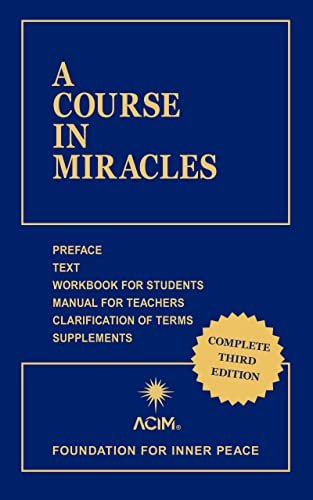
April 20, 2024
Coach G
No Comments
The Teachings of A Course in Miracles
In the expansive field of spiritual growth and personal transformation, A Course in Miracles (ACIM) stands out as a profound guide that promises to shift our perception of reality and bring us closer to inner peace. This self-study spiritual thought system was scribed by Dr. Helen Schucman in the 1970s, who claimed it was dictated to her by an inner voice she identified as Jesus. ACIM has since become a cornerstone for many spiritual seekers, blending spiritual wisdom with psychological insights to help individuals achieve a state of serenity and healing. In this comprehensive exploration, we will delve into the core teachings of ACIM and discuss how these principles can be practically applied in everyday life.
Core Teachings of A Course in Miracles
1. The Illusion of Separation
ACIM teaches that the world we perceive through our senses is not the true reality but an illusion created by the ego. This illusion reinforces the belief in separation—separation from others, from our true selves, and from God. The Course posits that in our essence, we are all one, interconnected by a shared divine essence. This concept is crucial as it shifts our understanding from seeing ourselves as isolated beings to recognizing our unity with all life.
2. The Power of Forgiveness
Forgiveness is a cornerstone of ACIM’s teachings, but it redefines forgiveness in a unique way. Traditional forgiveness often involves overlooking a transgression, but ACIM views forgiveness as recognizing that the perceived wrongs are mere illusions. By seeing beyond these illusions to the truth of our shared divinity, we release ourselves from cycles of guilt, resentment, and fear. True forgiveness heals our minds and relationships, restoring our awareness of unity and love.
3. Shifting Perception from Fear to Love
At the heart of ACIM is the teaching that we can choose to see every situation through the lens of either fear or love. The Course emphasizes that fear is a construct of the ego, whereas love is our true nature and the essence of the divine. By consciously choosing to perceive situations with love and compassion, we align ourselves with our higher selves and the divine will. This shift in perception is transformative, leading to a more peaceful and fulfilling life.
4. Inner Peace as a Path to Miracles
According to ACIM, miracles are natural expressions of love and occur when we align our thoughts and actions with love and truth. Miracles are not supernatural events but shifts in perception that allow us to experience healing and transformation. Inner peace is both a prerequisite for and a result of experiencing miracles. By cultivating inner peace, we create a fertile ground for miracles to occur in our lives.
In-Depth Applications of ACIM in Everyday Life
1. Practicing Forgiveness
Forgiveness, as taught by ACIM, is an ongoing practice that requires diligence and commitment. Begin by setting an intention each day to see beyond the illusions of grievances and to recognize the inherent goodness in others. When faced with conflict or hurt, take a moment to pause and reflect. Ask yourself, “What am I not seeing clearly?” and “How can I view this situation through the eyes of love?” This practice helps to dissolve the ego’s grip and opens the heart to genuine compassion and understanding.
2. Mindfulness and Awareness
Developing mindfulness is essential in applying ACIM’s teachings. Mindfulness involves being present and fully aware of our thoughts, feelings, and reactions. When fear-based thoughts arise, acknowledge them without judgment and gently shift your focus to thoughts aligned with love. This might involve silently affirming to yourself, “I choose love over fear,” or visualizing a situation bathed in light and love. Over time, this practice helps to rewire the mind to respond with love rather than fear.
3. Affirmations and Meditation
Affirmations are powerful tools for reprogramming the mind according to ACIM’s principles. Create a list of affirmations that resonate with you, such as “I am one with all that is,” “I forgive and release all illusions,” and “I choose love over fear.” Repeat these affirmations daily, especially during meditation. Meditation provides a quiet space to connect with your inner self and the divine. Focus on your breath, and allow yourself to be immersed in the present moment, letting go of past grievances and future worries.
4. Relationships as Classrooms
ACIM views relationships as sacred classrooms for spiritual growth. Each interaction with another person is an opportunity to practice forgiveness, compassion, and unconditional love. When conflicts arise, rather than reacting with anger or judgment, seek to understand the underlying fears and needs of the other person. By approaching relationships with an open heart and a willingness to heal, we transform them into powerful catalysts for personal and spiritual development.
5. Letting Go of Judgment
Judgment is a manifestation of the ego and reinforces the illusion of separation. Practice letting go of judgment by reminding yourself that everyone is on their unique spiritual journey. When you catch yourself judging others, take a step back and recognize that judgment only serves to strengthen your own ego. Replace judgment with acceptance and understanding. This shift not only heals your relationships but also brings you closer to inner peace.
6. Embracing Inner Guidance
ACIM emphasizes the importance of listening to the inner guidance of the Holy Spirit or your higher self. This inner voice is always available to guide you towards love and truth. Cultivate a habit of checking in with your inner guidance before making decisions or responding to challenging situations. This might involve asking, “What would love do in this situation?” or taking a few moments to quiet your mind and listen for intuitive insights. Trusting and following this guidance helps you navigate life from a place of wisdom and compassion.
7. Daily Practice and Integration
Integrating ACIM’s teachings into your daily life requires consistent practice. Set aside time each day for reflection, meditation, and study of the Course. Reflect on your experiences and how you can apply the principles of forgiveness, love, and inner peace. Journaling can be a helpful tool for this process, allowing you to track your progress and gain deeper insights. Remember that spiritual growth is a journey, and each step you take brings you closer to living a life aligned with love and truth.
8. Community and Support
Surrounding yourself with a supportive community can enhance your journey with ACIM. Engage with like-minded individuals through study groups, online forums, or spiritual retreats. Sharing experiences, discussing insights, and offering mutual support can provide encouragement and deepen your understanding of the Course’s teachings.
Conclusion
A Course in Miracles offers a transformative approach to spirituality, emphasizing forgiveness, love, and inner peace. By integrating its teachings into daily life, we can transcend the illusions of fear and separation, experience miracles, and awaken to our true nature. Whether you are new to ACIM or a seasoned student, the Course provides a profound path to spiritual growth and healing, reminding us of our inherent divinity and interconnectedness with all. Embrace the journey with an open heart and a willingness to see beyond the illusions, and you will discover the miraculous power of love and forgiveness in every aspect of your life.
Coach G, Dubai's Life Coach, combines ancient wisdom and quantum psychology to help you unlock your true potential and live your most empowered life.
From Our Blog
Share:
Categories
- A Course in Miracles - Weekly Study Guide 2
- Ancient Wisdom 14
- Book Summaries 20
- Coach G's Journal 55
- Conscious Motherhood 7
- Conscious Pregnancy 2
- Conscious Women 30
- Gloria’s Journal 6
- Life Coaching 80
- Marriage & Relationship 20
- Parenting 5
- Productivity 11
- Quantum Psychology 75
- Self-Improvement 103
- Spirituality 57
- Top Business Coaching Strategies 9
Popular Posts
The Monster Within: Embrace Your Shadow and Discover True Strength
December 4, 2025
Tags
Book Summary
Coach G
Coaching
consciousness
ego
Emotional Healing
Emotional Intelligence
Emotional Resilience
empowerment
enlightenment
faith
forgiveness
Growth Mindset
healing
Inner Peace
law of attraction
letting go
life coach
life coach Dubai
Life Coaching
Life Coaching Dubai
Manifestation
Mental Health
Mindfulness
Mindset Shift
oneness
Personal Development
personal growth
Personal Transformation
Positive Mindset
productivity
quantum psychology
relationships
Resilience
Self-Awareness
Self-Discovery
Self-Improvement
Spiritual Awakening
spiritual coach
spiritual growth
spirituality
Success Mindset
Time Management
Transformation
Universal Laws
Useful Links
Quick Menu
Contact Us
- +971585541780
- info@coach-g.com
- Al Murjan tower, Al Marsa Street Dubai Marina
© 2025 COACH G.











